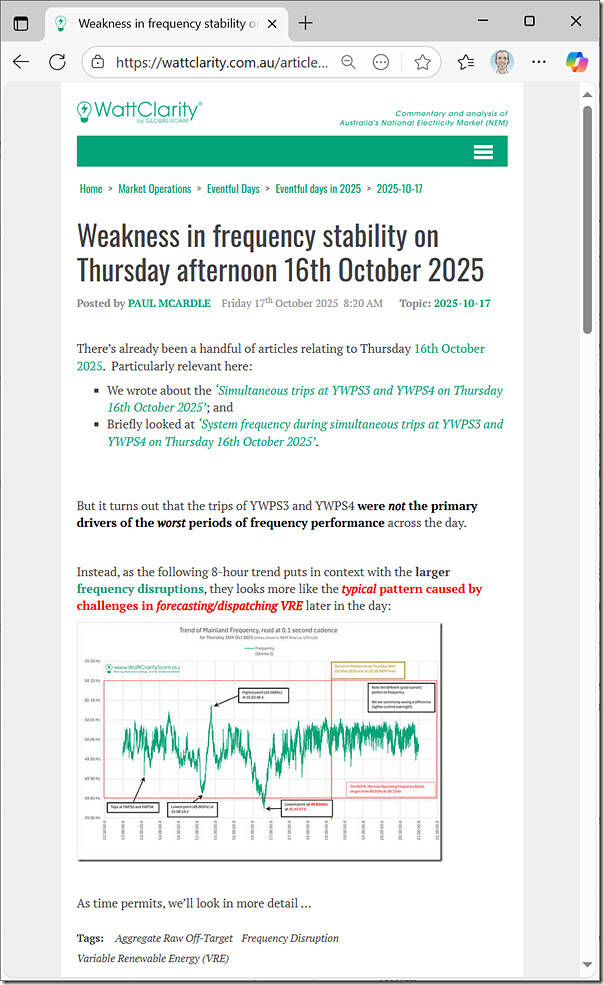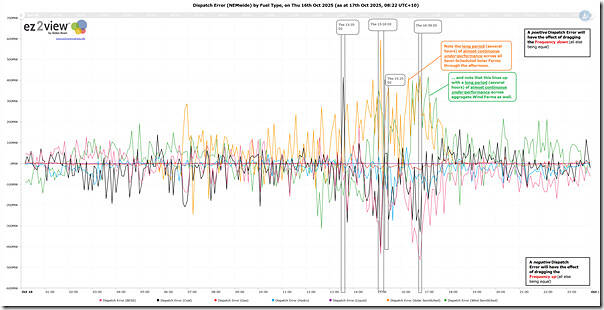Already this morning, with respect to yesterday, we’ve highlighted the ‘Weakness in frequency stability on Thursday afternoon 16th October 2025’:
… highlighting four particular dispatch intervals in which there were (progressively worse) frequency disruptions through the afternoon.
Trending Aggregate Dispatch Error, by Fuel Type
Now, with the use of the ‘Trends Engine’ within ez2view I’ve trended an aggregate for calculated ‘Dispatch Error’ for each of the Fuel Types NEM-wide through the day, and highlighted each of these dispatch intervals:
Remember that:
- Those with a licence to the software can open their own copy of this query here, and reset the date range to look at other days.
- To see a larger-resolution version of the image, click on it.
It’s plain to see that:
1) There’s a lengthy period through the afternoon where there is almost continuous collective (and large!) under-performance across all Semi-Scheduled Solar Farms NEM-wide.
(a) which would map to positive Aggregate Raw Off-Target
(b) and which would act to drag frequency down.
2) Unfortunately in this case, this also maps with a similarly lengthy period through the afternoon where there is almost continuous collective (and large!) under-performance across all Semi-Scheduled Wind Farms NEM-wide.
(a) again, mapping to positive Aggregate Raw Off-Target
(b) and which would also act to drag frequency down.
So is it any wonder that frequency control was poor through the afternoon?
A closer look at four Dispatch Intervals
Specifically looking at those four dispatch intervals:
| Dispatch Interval | Frequency Trend | Contributions (positive and negative) |
|---|---|---|
| 13:35 |
During this dispatch interval (with the trips of YWPS3 and YWPS4):
|
We know that YWPS3 and YWPS4 contributed to a positive Dispatch Error of +415MW (i.e. harmful) … but note that the total generation lost at those two units was ~600MW, meaning that other operational coal units provided a (beneficial) negative Dispatch Error of ~185MW Other beneficial impacts were:
Thankfully at this time, no other fuel type had a (harmful) positive Dispatch Error (which will be the reason why frequency was brought under control so quickly). |
| 15:10 |
During this dispatch interval, the frequency trended down, with the low point being 49.865Hz:
|
Unfortunately, the combined effect of Semi-Scheduled VRE in this dispatch interval was quite harmful to frequency stability:
What ‘saved the day’ (for those who liked to use the term), was:
|
| 15:25 |
Approximately 15 minutes after the low point above, the frequency had rebounded (a little too far):
|
In this case we see:
On the flip side, those dragging the frequency up (a little too far) were:
|
| 16:50 |
During this dispatch interval, the frequency trended down, with the low point being 49.824Hz:
|
Unfortunately, the combined effect of Semi-Scheduled VRE in this dispatch interval was even more harmful to frequency stability:
What ‘saved the day’ (for those who liked to use the term), was:
|
How long do we have to keep writing about these instances before action is taken:
1) e.g. via the AEMC, or the Nelson Review?
2) Surely it’s becoming increasingly clear that the Semi-Scheduled category is not sustainable or scalable?!




Leave a comment